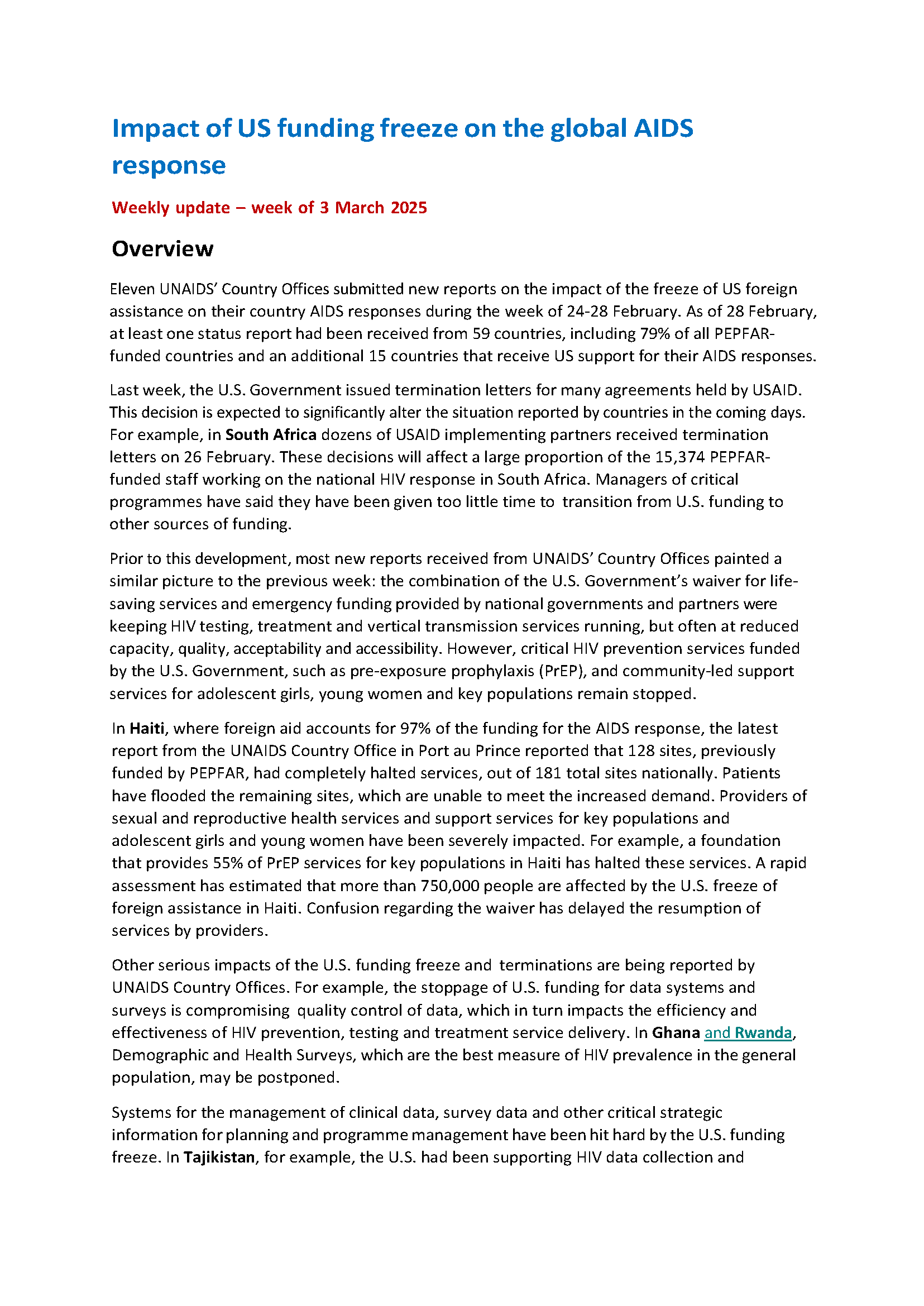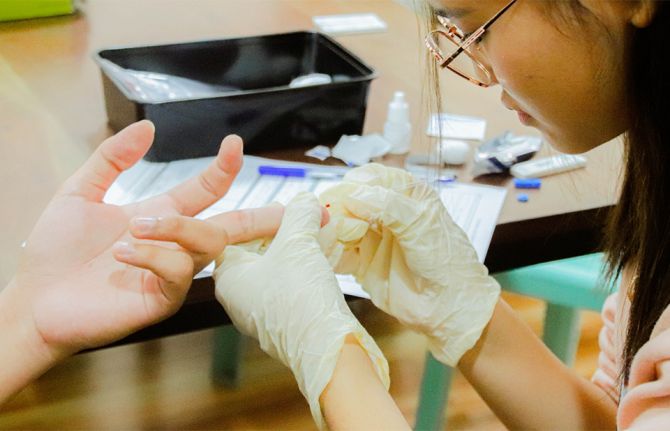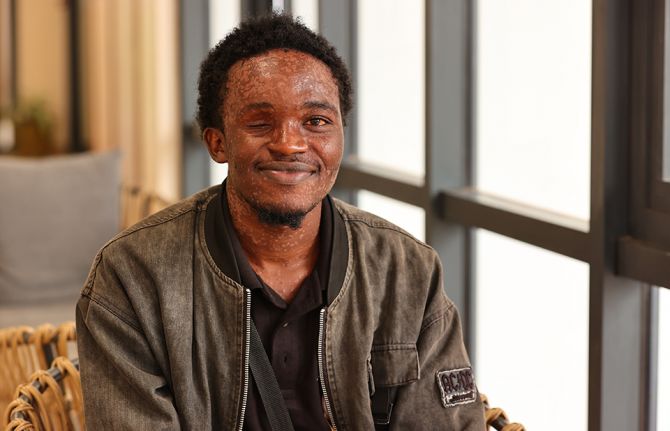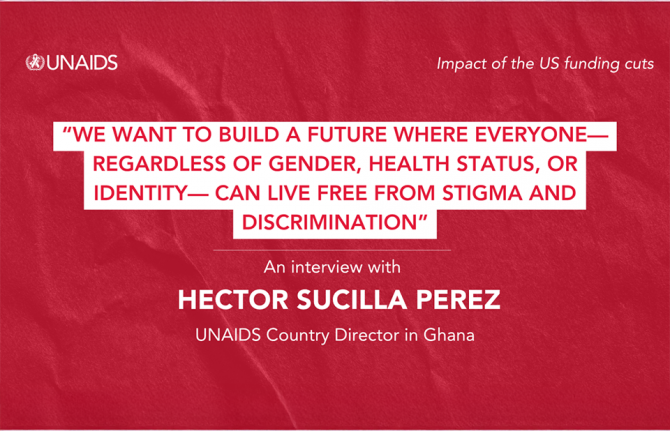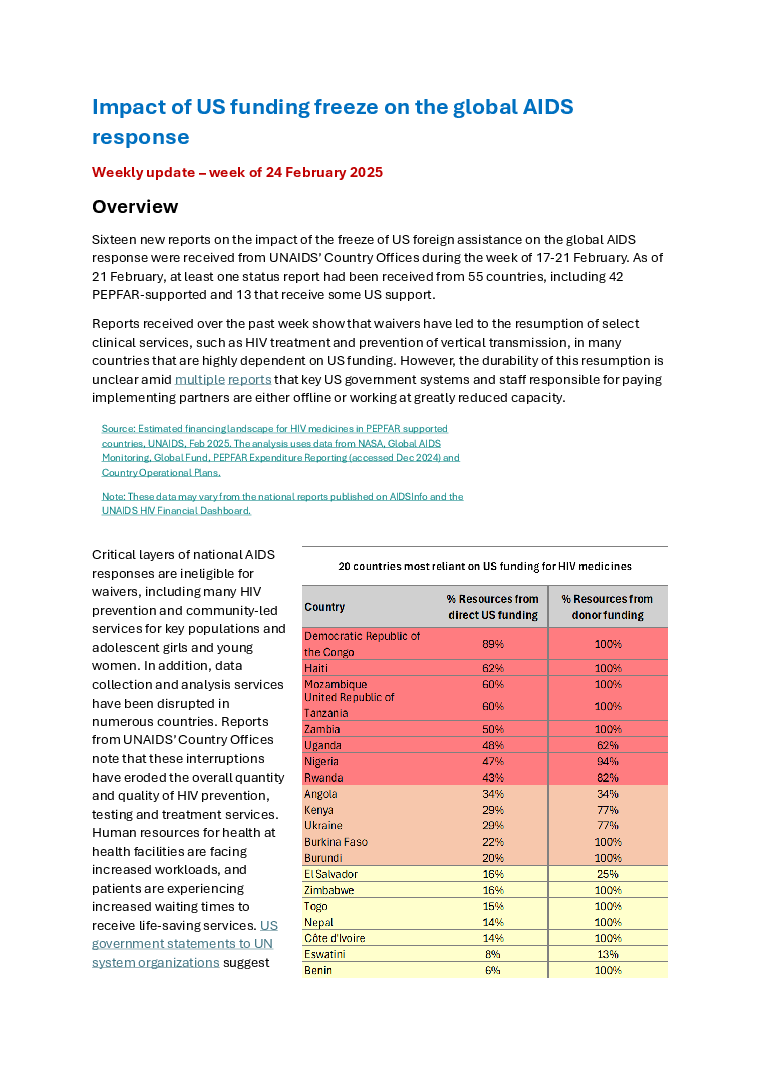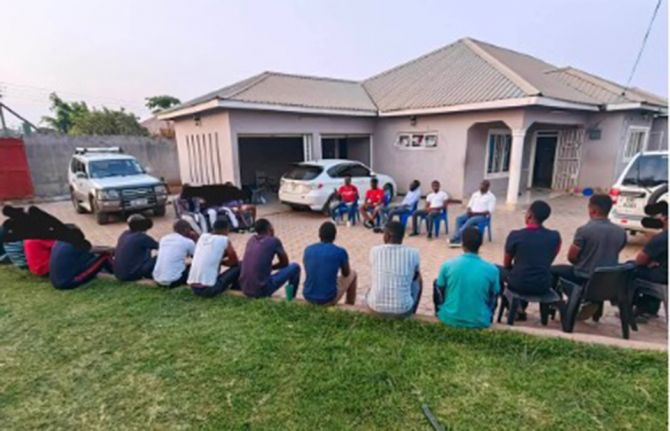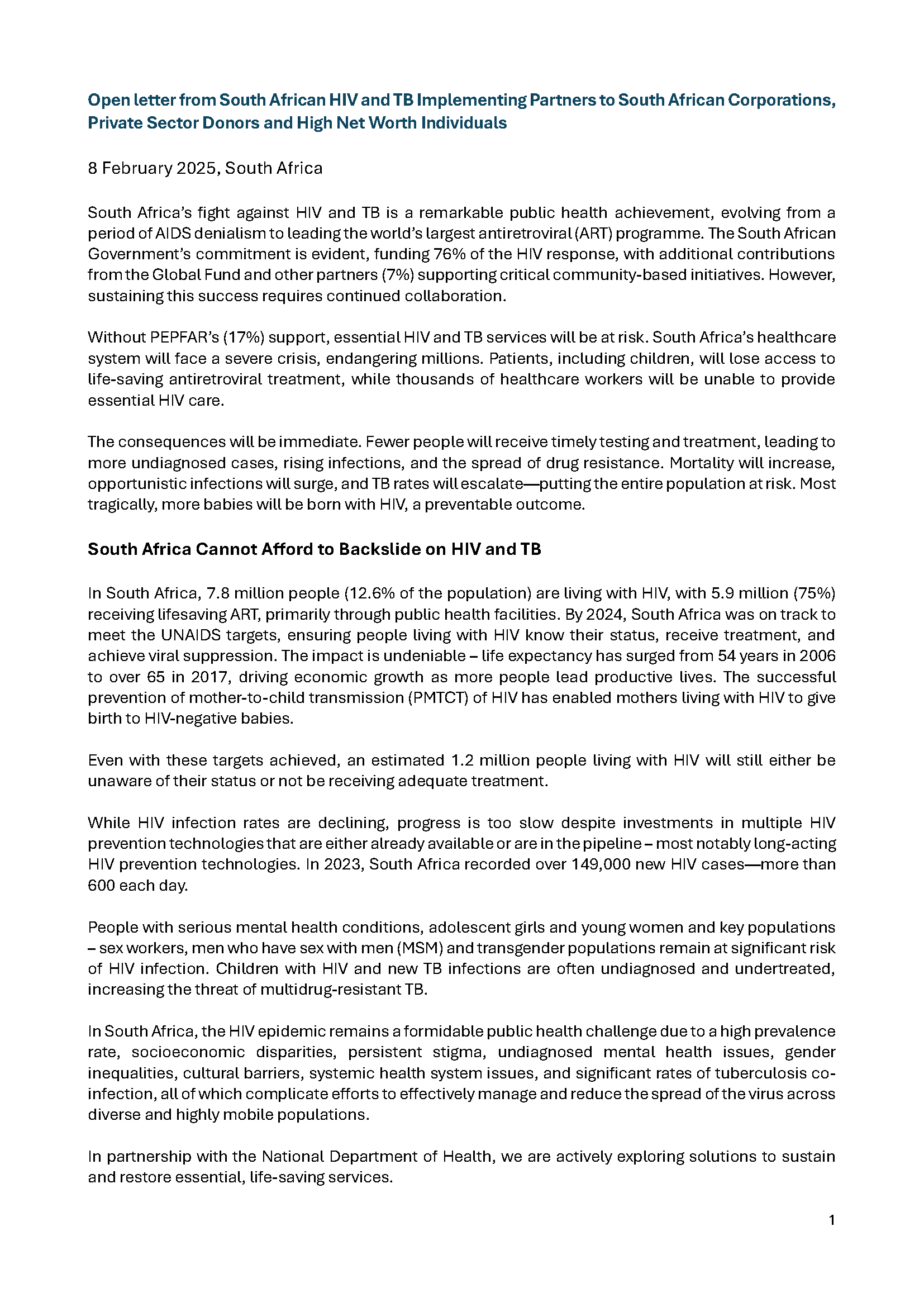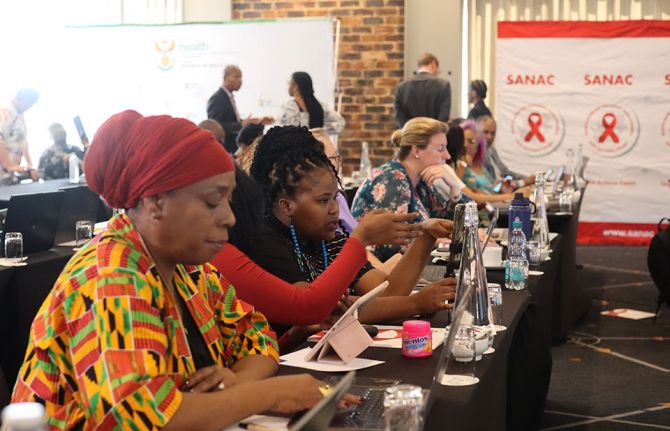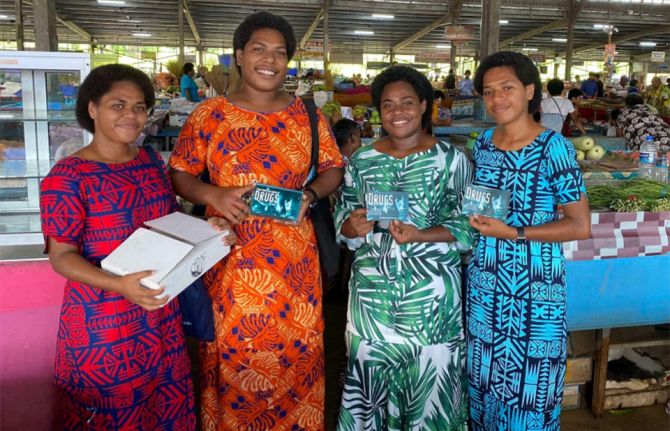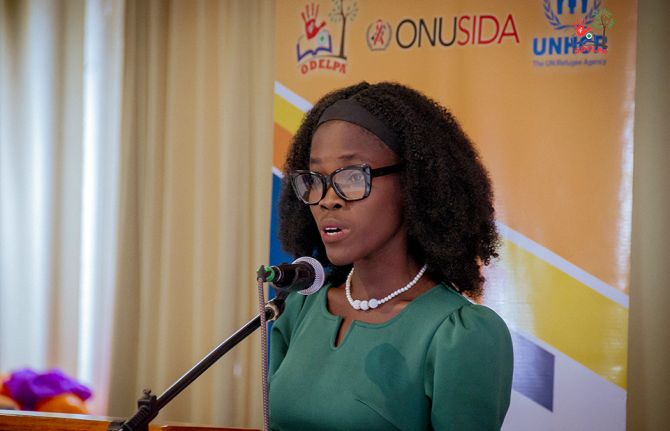
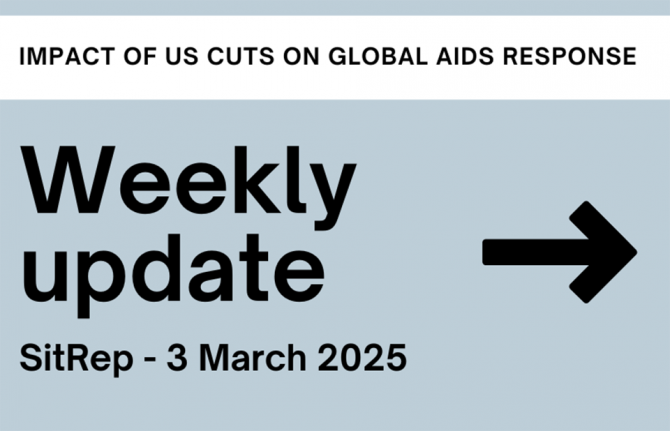
Feature Story
Impact of US funding freeze on the global AIDS response — Week of 3 March 2025 update
04 March 2025
04 March 2025 04 March 2025Eleven UNAIDS’ Country Offices submitted new reports on the impact of the freeze of US foreign assistance on their country AIDS responses during the week of 24-28 February. As of 28 February, at least one status report had been received from 59 countries, including 79% of all PEPFAR-funded countries and an additional 15 countries that receive US support for their AIDS responses.
Last week, the U.S. Government issued termination letters for many agreements held by USAID. This decision is expected to significantly alter the situation reported by countries in the coming days. For example, in South Africa dozens of USAID implementing partners received termination letters on 26 February. These decisions will affect a large proportion of the 15,374 PEPFAR-funded staff working on the national HIV response in South Africa. Managers of critical programmes have said they have been given too little time to transition from U.S. funding to other sources of funding.
Related

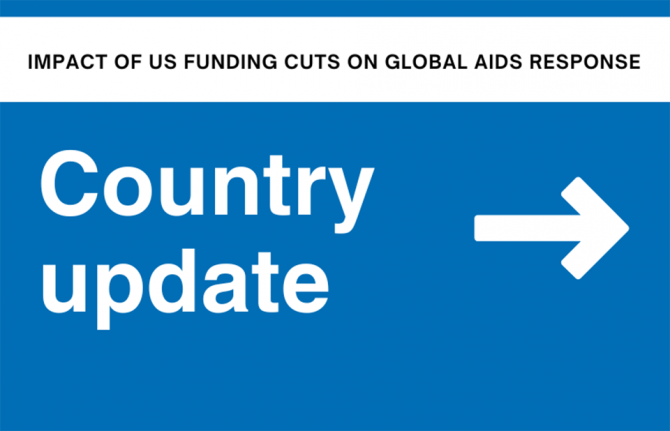
Feature Story
Status of HIV programmes in Mali
04 March 2025
04 March 2025 04 March 2025New funding for the HIV project implemented by FHI360 – previously supported by U.S. funding - in Mali has been allocated. Once the funds are deployed, the project will be able to resume its activities.
This is significant as the work of associations and NGOs had nearly come to a standstill due to the suspension of U.S. funding.
Following a report on the impact of the U.S. funding suspension on the community response to HIV, the Malian Government allocated 120 million CFA francs to affected associations to help them continue their activities and mitigate the negative effects of the suspension. This decision was made during a meeting on February 28, organized jointly by the UNAIDS Country Office and the Executive Secretary of the High National Council for the Fight against AIDS.
Despite the reinstatement of funding for the FHI360 project, there are still immediate risks and disruptions to HIV programmes in Mali. The suspension of U.S. funding to PEPFAR has caused disruptions in HIV treatment, testing, and prevention services. This has led to clinic closures and health workers being put on leave, which poses a significant risk to the continuity of HIV services in Mali.
Region/country
Related


Feature Story
Impact of US funding freeze on the global AIDS response — Weekly update
26 February 2025
26 February 2025 26 February 2025Sixteen new reports on the impact of the freeze of US foreign assistance on the global AIDS response were received from UNAIDS’ Country Offices during the week of 17-21 February. As of 21 February, at least one status report had been received from 55 countries, including 42 PEPFAR-supported and 13 that receive some US support.
Reports received over the past week show that waivers have led to the resumption of select clinical services, such as HIV treatment and prevention of vertical transmission, in many countries that are highly dependent on US funding. However, the durability of this resumption is unclear amid multiple reports that key US government systems and staff responsible for paying implementing partners are either offline or working at greatly reduced capacity.
Critical layers of national AIDS responses are ineligible for waivers, including many HIV prevention and community-led services for key populations and adolescent girls and young women. In addition, data collection and analysis services have been disrupted in numerous countries. Reports from UNAIDS’ Country Offices note that these interruptions have eroded the overall quantity and quality of HIV prevention, testing and treatment services. Human resources for health at health facilities are facing increased workloads, and patients are experiencing increased waiting times to receive life-saving services. US government statements to UN system organizations suggest US-funded programmes focused on gender equality and transgender populations may not resume.
Related


Feature Story
Zambia - an HIV response at a crossroads
24 February 2025
24 February 2025 24 February 2025The United States Government (USG) support to Zambia is estimated at $600 million annually, of which $367 million was committed for the national HIV response for 2025 under the Presidential Emergency Plan For AIDS Relief (PEPFAR).
The USG pause in foreign assistance has caused significant disruption to HIV services in Zambia, with HIV prevention services being hardest hit. HIV Combination prevention for adolescent girls and young women as well as for other marginalized and vulnerable communities are most impacted.
A total of 32 drop-in centers that provide HIV services to over 20,000 key populations living with HIV on ART in 7 out of 10 provinces have been shut down. Additionally, USG-supported DREAMS centers for adolescent girls and young women in 21 districts have been closed. Further, 16 standalone centers providing voluntary medical male circumcision have also stopped operating. Almost half (49%) of the PrEP services in Zambia are USG supported.
Human resources for HIV service delivery are also at risk. The USG supports over 23,000 personnel, with over 11,500 being health workers and community-based volunteers supporting the national AIDS response. The Government may not be able to absorb these health workers immediately. Consequently, opportunities for task shifting and better integration of services are being explored by the Government.
In view of the waiver on service delivery, USG Implementing partners are incrementally resuming services but with a lot of caution. HIV services are at a complete standstill in the six districts of the Northern Province, where Right to Health is the only USG implementing partner.
There is an adequate supply of ARVs for the next 12 months, but without buffer for the period. Available and pipeline HIV rapid test kits are expected to last 3.2 months, with 4 months for tuberculosis x-pert cartridges and a one-month supply for viral load testing and early infant diagnosis.
The Ministry of Health is committed to ensuring the uninterrupted provision of essential HIV, TB and Malaria services across all public health facilities and has issued directions and guidance to this effect. The UN Joint Team on HIV and AIDS has supported the Ministry of Health to establish a high-level steering committee to identify gaps and develop a response plan to mitigate the impact of the “pause orders” for the HIV response. A costed-impact mitigation plan based on the minimum package of HIV services essential for continuity has been developed and presented to the Government and Cooperating Partners. In line with the HIV Response Sustainability Roadmap 2025-2030 that was launched in December 2024, the Joint Team is working with the Ministry of Health and the National AIDS/TB/STI Council (NAC) to explore and implement medium and long-term solutions for sustaining the national AIDS response.
Region/country


Feature Story
Comprehensive update on HIV programmes in South Africa
25 February 2025
25 February 2025 25 February 2025Due to the U.S. Government’s freeze of foreign assistance, 15,374 PEPFAR-funded HIV response staff across national and 27 priority districts have been affected, with an estimated HR cost of ZAR 4.6 billion (~USD 250 million), and approximately 222,000 people living with HIV, including 7,445 children under the age of 15, face disruptions in their daily antiretroviral therapy supplies.
Documented Impact on Services as of 20 February
- PEPFAR-funded Projects: Last week, PEPFAR-funded projects in South Africa received waiver letters, prompting a review of their activities. The CDC has communicated with beneficiary organizations, while USAID-supported partners remain closed.
- Service Disruptions: The closure of the TB/HIV Care clinic in Tshwane, Pretoria, has significantly impacted people living with HIV, particularly the homeless, of whom 70% are drug users.
- The halt in US Government support has led to a pause in the Ritshidze (“Saving Our Lives”) Community-led monitoring project. Established in 2019, the project monitors more than 400 public clinics and community healthcare centers, located in 27 priority districts and 8 provinces of South Africa. The facilities were chosen to cover nearly half of all people living with HIV on treatment in the country, with a focus on sites with large treatment cohorts and where the data show poor linkage and retention rates.
Human Rights, Key, and Vulnerable Populations
- People who use drugs: Service disruptions pose a high risk of needle sharing and antiretroviral interruptions due to the lack of referral letters required by some government facilities. This increases the risk of HIV viral rebound and transmission among the estimated 80,000 people who use drugs in the country.
- LGBTQ+ communities: Facilities like Engage Men’s Health, which support gay and bisexual men and men who have sex with men, remain closed. This closure heightens the risk of stigma, discrimination, and potential resurgence of new HIV infections among these marginalized populations.
Government convening and mitigation measures
- ART Dispensation: The Department of Health has implemented a 6-month antiretroviral therapy dispensation for eligible patients to reduce clinic visits and ease the workload on health workers.
- Telemedicine and Digital Health: Efforts are being made to strengthen telemedicine and digital health platforms for HIV prevention and treatment services.
- Private Sector and Civil Society Partnerships: The Department of Health is encouraging partnerships to support key populations' HIV services.
- Diplomatic Discussions: President Ramaphosa has convened a high-level delegation for diplomatic discussions with China and Russia.
- Civil Society Impact, Resilience, and Response
- NGO Closures: NGOs reliant on USAID funding remain closed, affecting community-based programs and outreach services, including HIV testing, in USAID-supported districts.
- Research and Clinical Trials: South African universities and research institutions are concerned about the impact of the funding freeze on research and clinical trials. There is uncertainty about research funding, with fears that NIH-backed projects could be at risk.
Region/country


Feature Story
Status of HIV Programmes in Indonesia
24 February 2025
24 February 2025 24 February 2025Documented Impact on Services
Indonesia has had to pause many programmes due to the U.S. funding freeze. All community led activities funded through USAID have been paused and prevention and linkages to treatment for around 30% of men who have sex with men (MSM) in Jakarta have been affected. In addition, the expansion of PrEP programmes and a test pilot of long-acting HIV pre-exposure prophylaxis (PrEP) have been halted for now.
The HIV epidemic in Indonesia is mostly concentrated among key populations (MSM, sex workers, people who inject drugs and transgender people) except in Tanah Papua, where the epidemic is generalized. There are nearly 80 000 MSM in Indonesia’s capital.
There are an estimated 570,000 people living with HIV in Indonesia. Addressing the treatment gap is one of the country’s biggest challenges. Only 31% of people living with HIV are accessing treatment and 14% are virally suppressed.
First line HIV treatment is provided for free for PLHIV and is fully funded by the government as are HIV testing kits and CD4 and viral load testing kits. However, HIV self-testing kits, condoms, clean needles, PrEP and long-acting HIV pre-exposure prophylaxis are procured with the support of the Global Fund.
HIV prevention programmes depend heavily on the Global Fund and USAID, especially regarding community outreach and peer support. The Global Fund investment is focused in 178 HIV priority districts with an allocation of $102 million for three years (2024-2026). The US government made an annual investment of $11 million for the HIV response in Indonesia in 2024-25. This includes above site technical assistance for the national HIV program implemented through US-based consulting agencies such as JSI/Think Well and through multilateral agencies including UNAIDS; as well as on-site intervention for PLHIV and key populations in the city and greater Jakarta implemented by EPIC/FHI360.
Region/country


Feature Story
Status of HIV Programmes in Botswana
20 February 2025
20 February 2025 20 February 2025Documented Impact on Services:
Government Support: HIV programmes are primarily (60%) supported by the government, with public health facilities operating normally.
Service Disruptions: All key population drop-in centres are closed, limiting access to services.
Workload and Quality: Increased workload for government staff may hinder adequate monitoring of adherence and retention for clients on treatment. There is a risk of losing trained staff, which could lead to poorer service quality.
Medium-Term Risks: The quality, efficiency, and sustainability of the national HIV response may be affected due to halted US Government-funded technical assistance in critical areas like the National Sustainability and Transition of TB and HIV roadmap, the development of the National Strategic Framework IV, and HIV estimates for children and breastfeeding women.
Human Rights, Key and Vulnerable Populations:
Service Gaps: The pause in U.S. assistance to community programs and drop-in centres means tens of thousands will lose access to critical services such as HIV testing, ART, PrEP, and screenings for tuberculosis and sexually transmitted infections.
Closure of Drop-In Centres: Most drop-in centres for key populations are closed, with only one in Gaborone partially open. This closure affects safe spaces for key populations, potentially leading to treatment default.
Government Convening and Mitigation Measures:
Task Force: A Joint Oversight Committee Task Team - including government, civil society organizations, and other partners co-chaired by UNAIDS - has been established to monitor the impacts of the pause order and develop mitigation measures.
Referral Systems: The Ministry of Health is working with civil society organizations (CSOs) to ensure clients whose usual drop-in-centers have been closed are informed of where to access services.
Civil Society Impact, Resilience, and Response:
CSO Collaboration: Measures are being put in place to ensure that CSO-provided services that have been closed collaborate with government-funded CSOs and refer clients to government facilities. However, demand creation related to vertical transmission and pediatric HIV has been affected. UNAIDS is facilitating regular dialogues of CSOs to assess the situation and collectively decide on mitigating measures.
AGYW Services: Services for adolescent girls and young women (AGYW) have been closed, with clients referred to Ministry of Health youth-friendly service points. Referral channels for structural and social services for AGYW are still unclear.
Community-Led Monitoring (CLM): CLM is primarily supported by the Global Fund and domestic funding. The halt in US Government support affects the implementation and monitoring of CLM.
Politically Relevant Updates
Government Actions: The government, through the National AIDS and Health Promotion Agency and the Ministry of Health, is actively involved in mitigating the impacts of the pause order and ensuring the continuity of essential services.
International Support: The involvement of UNAIDS and other development partners highlights the international community's role in supporting Botswana's HIV response.
Region/country
Related


Feature Story
Impact of the pause of US foreign assistance in Côte d'Ivoire
19 February 2025
19 February 2025 19 February 2025A confusing and evolving situation in Côte d'Ivoire
The 90-day pause in US foreign assistance has caused a major shock to the national response to AIDS in Côte d’Ivoire. While the US Government released an emergency humanitarian waiver allowing some lifesaving HIV services to move forward during the overall pause, a lack of clarity about what is allowed has led to interruptions in services, even for HIV treatment which is allowed under the waiver. 85% of PLHIV on ART in Cote d’Ivoire are directly supported by the US President’s Emergency Plan for AIDS Relief (PEPAR) programme.
The US funding pause is creating anxiety and confusion among beneficiaries, service providers and programme managers. Partners in the AIDS response are reporting a lack of clarity about how to operationalize the waiver —restarting treatment-related activities in line with the waiver is proving much more difficult than stopping all activities.
For example, government-run clinics and health centres are experiencing staff shortages as some health personnel have had to stop work to comply with the original US President’s Executive Order as PEPFAR tops up their government salaries.
To assess the situation, UNAIDS has been consulting regularly with national AIDS programme managers, development partners and with civil society and community-led organizations to get a clearer picture of the situation on the ground.
Both civil society and the national AIDS programme (MoH) have developed plans for the way forward.
Findings
The immediate and effective application of the stop-order is creating an alarming situation in terms of the provision and access to services.
There is a significant communication lag regarding the waiver. Civil society organizations are particularly grappling with how, exactly, to implement the terms of the waiver given considerable budget cuts and given the waiver does not allow for certain complementary support services. This is particularly the case for activities for which US funding complements other sources of funding such as the Global Fund or government resources.
Main impacts
On health services:
- Immediate large-scale interruption of HIV-related services, including medical examinations and laboratory services
- There is a significant risk to adherence to ARV treatment
- There is a threat to the continued implementation of the Paediatric Action Plan.
- Tuberculosis programmes have been impacted through the cessation of Stop TB Partnership funding.
Critical national strategic planning processes led by the MoH have been interrupted: 2025 spectrum estimates, CIPHIA HIV survey, HIV sustainability roadmap
On civil society organizations
- There is a considerable real impact on operational and programmatic activities, including human resources.
Widespread temporary and permanent layoffs are reported and associated legal risks related to employee contracts.
- An inability to cover operating costs.
- Co-funded activities and programmes are stopped because critical components are financed by PEPFAR
- A threat to business continuity and long-term loss of capacity and expertise
There is a disproportionate impact on vulnerable populations who not only no longer benefit from funding for their prevention, treatment and care activities but may also see their funding from PEPFAR threatened in the long term.
Solutions and Strategic Recommendations
Immediate actions:
- Continued dialogue and joint assessment with the government, civil society and development partners.
- Strengthen and integrate short and medium-term contingency planning.
- Accurately document the interruption of services.
- Improve sharing of information with stakeholders and reassure patients and affected populations.
Resilience strategies :
- Maintain and accelerate the medium- and long-term sustainability process in this context and ensure that the current situation is considered in this work.
Explore new partnerships and mobilise alternative resources
(private sector, other donors).
- Optimise the efficiency of programmes.
- Monitor the impact of the pause on access to services for the most vulnerable, on community structures and their ability to deliver community-led responses.
Critical points
- High risk to the continuity of health services.
- High risk of non-renewal of activities relating to vulnerable populations.
- Need for a collaborative approach between CSOs, the State and international partners.
UNAIDS is holding follow up consultations with government, civil society organizations and international partners to analyse needs during the pause and to coordinate efforts to ensure the continuity of HIV services.
Region/country
Related


Feature Story
Impact of the pause of US foreign assistance in Côte d'Ivoire
23 February 2025 10 March 2025A confusing and evolving situation in Côte d'Ivoire
The 90-day pause in US foreign assistance has caused a major shock to the national response to AIDS in Côte d’Ivoire. While the US Government released an emergency humanitarian waiver allowing some lifesaving HIV services to move forward during the overall pause, a lack of clarity about what is allowed has led to interruptions in services, even for HIV treatment which is allowed under the waiver. 85% of PLHIV on ART in Cote d’Ivoire are directly supported by the US President’s Emergency Plan for AIDS Relief (PEPAR) programme.
The US funding pause is creating anxiety and confusion among beneficiaries, service providers and programme managers. Partners in the AIDS response are reporting a lack of clarity about how to operationalize the waiver —restarting treatment-related activities in line with the waiver is proving much more difficult than stopping all activities.
For example, government-run clinics and health centres are experiencing staff shortages as some health personnel have had to stop work to comply with the original US President’s Executive Order as PEPFAR tops up their government salaries.
To assess the situation, UNAIDS has been consulting regularly with national AIDS programme managers, development partners and with civil society and community-led organizations to get a clearer picture of the situation on the ground.
Both civil society and the national AIDS programme (MoH) have developed plans for the way forward.
Findings
The immediate and effective application of the stop-order is creating an alarming situation in terms of the provision and access to services.
There is a significant communication lag regarding the waiver. Civil society organizations are particularly grappling with how, exactly, to implement the terms of the waiver given considerable budget cuts and given the waiver does not allow for certain complementary support services. This is particularly the case for activities for which US funding complements other sources of funding such as the Global Fund or government resources.
Main impacts
On health services:
- Immediate large-scale interruption of HIV-related services, including medical examinations and laboratory services
- There is a significant risk to adherence to ARV treatment
- There is a threat to the continued implementation of the Paediatric Action Plan.
- Tuberculosis programmes have been impacted through the cessation of Stop TB Partnership funding.
Critical national strategic planning processes led by the MoH have been interrupted: 2025 spectrum estimates, CIPHIA HIV survey, HIV sustainability roadmap
On civil society organizations
- There is a considerable real impact on operational and programmatic activities, including human resources.
Widespread temporary and permanent layoffs are reported and associated legal risks related to employee contracts.
- An inability to cover operating costs.
- Co-funded activities and programmes are stopped because critical components are financed by PEPFAR
- A threat to business continuity and long-term loss of capacity and expertise
There is a disproportionate impact on vulnerable populations who not only no longer benefit from funding for their prevention, treatment and care activities but may also see their funding from PEPFAR threatened in the long term.
Solutions and Strategic Recommendations
Immediate actions:
- Continued dialogue and joint assessment with the government, civil society and development partners.
- Strengthen and integrate short and medium-term contingency planning.
- Accurately document the interruption of services.
- Improve sharing of information with stakeholders and reassure patients and affected populations.
Resilience strategies :
- Maintain and accelerate the medium- and long-term sustainability process in this context and ensure that the current situation is considered in this work.
Explore new partnerships and mobilise alternative resources
(private sector, other donors).
- Optimise the efficiency of programmes.
- Monitor the impact of the pause on access to services for the most vulnerable, on community structures and their ability to deliver community-led responses.
Critical points
- High risk to the continuity of health services.
- High risk of non-renewal of activities relating to vulnerable populations.
- Need for a collaborative approach between CSOs, the State and international partners.
UNAIDS is holding follow up consultations with government, civil society organizations and international partners to analyse needs during the pause and to coordinate efforts to ensure the continuity of HIV services.
Region/country
Related


Feature Story
Comprehensive Update on HIV Programmes in the Dominican Republic
19 February 2025
19 February 2025 19 February 2025The HIV programmes in the Dominican Republic are currently facing several challenges and disruptions, primarily due to shifts in US funding and political dynamics. Here are the key points:
PEPFAR-Funded Programmes:
PEPFAR-funded HIV programmes, which were stopped, are now being resumed. For instance, while services for people living with HIV have already been opened, including services offered by civil society, community support, and support for human resources at the government level among others, the opening process has been slow. And while PEPFAR-funded HIV care programmes are resuming, other activities such as PrEP for key populations and Community-Led Monitoring remain on hold.
Furthermore, the new Global Fund grant started in January 2025 has not yet been implemented at the site level.
Service Disruptions:
The PEPFAR program in the country is mainly focusing on the Haitian migrant population and therefore, the suspension of funding has raised concerns regarding Haitian migrants not having access to their treatment programmes.
The absence of USAID-funded staff and the suspension of transportation services that helped patients reach healthcare centers may impact service accessibility.
There have been debates in the media about the need to maintain internationally funded HIV programs, particularly those targeting Haitian immigrants.

